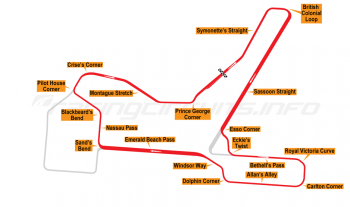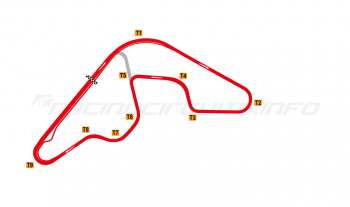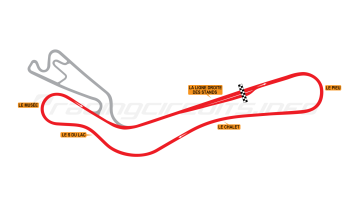Korea International Circuit
Circuit Overview
The Korea International Circuit (Korean: 코리아 인터내셔널 서킷) has had a troubled start to life, bursting onto the F1 scene in 2010 but dropped from the calendar after just four events.
Supposedly part permanent, part temporary, the harbourside section of the course featuring the pits and paddock area was intended to be developed into a city district, with shops, restaurants and exhibition venues, to create a "Monaco-style" street circuit feel.
In reality, these developments never came, leaving a somewhat industrial backdrop to the track and meaning the circuit has always operated as a year-round motorsports facility.
It seems unlikely that Formula One will ever return and so the circuit is set to be a regional and domestic venue only for now.
Circuit History
Bringing a Grand Prix to South Korea had long been an objective for Bernie Ecclestone, but following a previous abortive effort at Sepoong, a deal was finally struck for the race to be held at a new harbour-side venue in Yeongam, South Jeolla, some 400 kilometres south of Seoul and near the port city of Mokpo. The original deal wit Korean F1 promoter Korea Auto Valley Operation (KAVO – a joint venture between M-Bridge Holdings and Jeollanam-do regional government) was for $264 million and would see F1 visiting until 2021.
KAVO announced in September 2009 that the funding was in place to start construction at the site, and officials were confident the work would be completed in time to hold a Grand Prix in 2010. Work was slated to finish in July 2010, in time for the first Grand Prix in October.
Hermann Tilke was employed to design the facility, as has become customary for F1 venues. On a largely flat parcel of land, Tilke proposed a typical mix of overtaking-friendly sharp hairpins plus a couple of quick corners. Uniquely, it was intended from the outset that the circuit would be part urban street course and part permanent venue, with the permanent facilities in the north being used for events year round and the southern half, complete with F1 standard pit and paddock facilities, would be used for the yearly visit of F1 only.
Around the southern circuit it was envisaged a village of hotels, restaurants and marinas would spring up, to create a harbour-side atmosphere similar to Yas Marina, the Valencia street course or Monaco.
Construction appeared to be on schedule in December 2009, but then a long period of poor weather hampered proceedings, leading to speculation that the track would not be complete in time. Despite this, organisers for the race announced the circuit's opening date to be 5 September 2010. On 4 September 2010, in an event called 'Circuit Run 2010', a Red Bull Racing Formula 1 show car with Karun Chandhok at the wheel completed 14 laps of the circuit, with 4,000 fans in attendance.
The FIA track inspection was delayed several times while final works were completed, and the circuit was only given official approval 11 days before the first F1 race. Nevertheless, when the F1 circus arrived, they found work still continuing. The smell of fresh paint permeated the pit buildings and the track surface was actually only complete up to the first layer. It would take another year for the circuit to be considered properly complete.
Final construction costs were announced as around $77 million (88 billion won) – some way in excess of the 52.8 million won original funding raised. No doubt the difficulties of raising the remainder have been a contributing factor in the loss of the Grand Prix.
Drivers found a circuit with typical Tilke embellishments – the footbridge over the final turn drawing its inspiration from local architecture, for example. However, problems immediately emerged with the pit lane entry and exit, which had not been constructed as per the plans but instead saw cars enter and exit directly on the racing line.
In response, circuit bosses moved the wall at Turn 17 back in 2011 to improve visibility at that part of the track, so drivers on a hot lap can see drivers slowing to go into the pits, while a traffic light system was installed at pit out to warn drivers of oncoming cars on the start/finish straight.
Finally, the pit exit was modified in 2013 to skirt around the run-off for Turn 1, rejoining at Turn 2. Even this had its issues, however; the quality of the work was been called into question by many drivers, with many highlighting an uneven surface due to having to run through a drainage channel. It's also debatable whether exiting into Turn 2 does not bring its own difficulties.
It's probably fair to say that F1 never really took to Korea and, given the relatively small and uninterested crowds that showed up to watch, it is equally fair to suppose the feeling was mutual.
The Korean circuit was included in the 2012 FIA GT1 World Championship calendar, but later it was removed. Later that year however, it was announced that the circuit would host an exhibition round of the 2013 Super GT season; this too was eventually postponed, never to be run.
The circuit has, however, gone on to establish itself as a relatively popular local venue, while it has been a frequent part of the GT Asia Series.
In 2019, a new link road was constructed to create a shorter version of the Grand Prix circuit, the main advantage being it can be used at the same time as the national circuit.
Jump onboard
Circuit info
- Korea International Circuit, Jeollanam-do, Yeongam-gun, Samho-eup, Sampo-ri 745, South Korea
- +82-61-288-4207
- Official website
Rate This Circuit
Votes: 7466
Plan a visit
Get your race tickets!
Brought to you with: 
We've teamed up with Motorsports Tickets to bring you the best deals for Formula One, MotoGP, Le Mans and more.
















